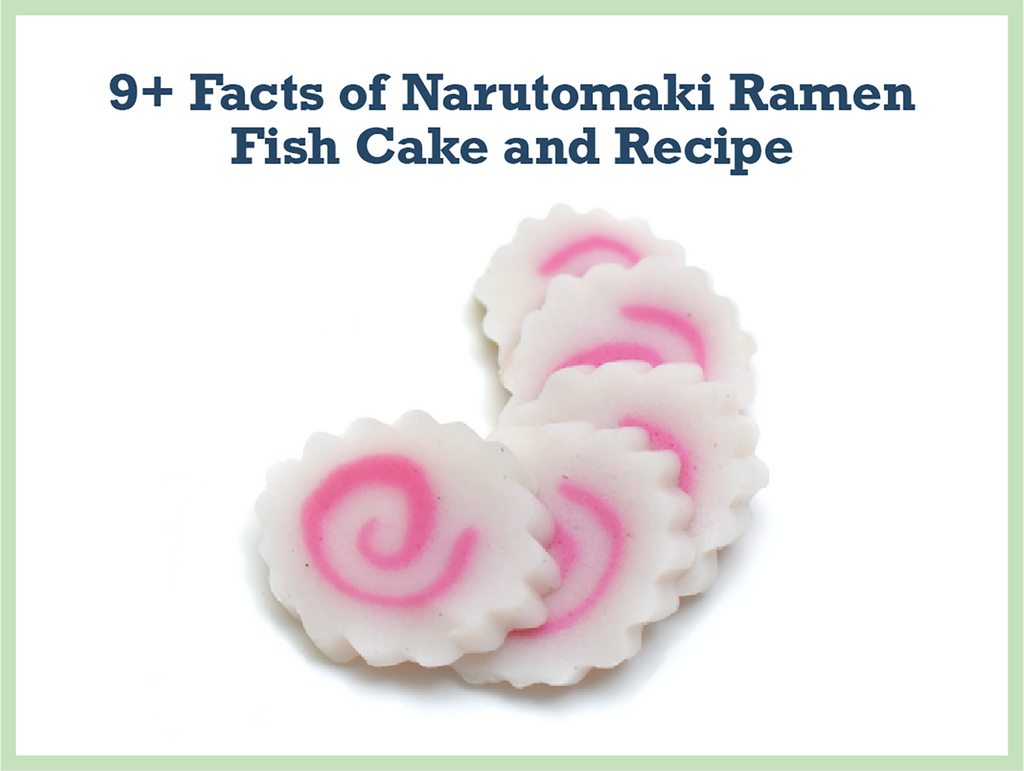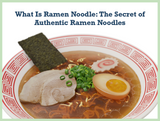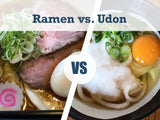
Hey there! Have you ever tried Narutomaki in your ramen?
If not, you're missing out!
Narutomaki is a type of fishcake.
It's made from a mixture of fish paste that's rolled and steamed to create a solid shape.
You'll love the unique swirl pattern and the delightful combination of pink and white colors.
Trust me, once you try Narutomaki, you'll never go back to plain old ramen again!
Why did Narutomaki never feel lonely?
Because it was always surrounded by its "swirl-mates"!
For a bowl of ramen…

Narutomaki is something like Chaozu in Dragon Ball Z
He doesn’t have much presence in the Z fighters,
But if he is not there, you feel something is missing.
I have never met a person saying their favorite ramen topping is narutomaki,
But if there is no narutomaki in my shoyu ramen,
I feel something is off.
What about you?
Are you familiar with naruto?
If not, don't worry, I will explain what they are in detail and answer these questions below.
1. What do you mean by "fish cake"?
2. What is Narutomaki?
3. Why is it called "Narutomaki"?
4. How is a narutomaki made?
5. What are the different patterns of Narutomaki?
6. How can I make a narutomaki?
7. How can I cut a narutomaki up the right way?
8. Where can I buy narutomaki?
9. Why is narutomaki used as a ramen topping?

Let me answering your questions one by one...
1. What do you mean by "fish cake"?

You form the fish paste in certain shapes and heat it up to solidify it.
(In Japanese, white fish paste is called surimi)
There are so many different fish cakes in Japan.
And they are either grilled, steamed, boiled, or deep fried in order for these shapes to solidify.
These are examples of different kinds of fish cakes...
1. Boiled: Hanpen, tsumire
2. Deep fried: Satsuma age, tsuke age, gansu, jakoten
3. Grilled: Chikuwa, sasa kamaboko, datemaki
4. Steamed: Ita kamaboko, imitation crab, fish sausage, narutomaki

The interesting thing about fish cake is, it sticks with umami despite the fact that other similarly processed marine products focus on preservation.
There are so many different kinds of fish cakes besides narutomaki!
But since this is a ramen blog, and narutomaki is a ramen topping, I will be talking about narutomaki in detail...
2. What is Narutomaki?
It is also called the "naruto fish cake".Narutomaki has a long history.
Keep reading and you will find out...
i. Narutomaki was in a book published in 1846
The oldest detailed description about narutomaki was in a book called "Konnyaku Hyaku chin".
According to this book, people in the Edo period (1603-1868) wrapped narutomaki in kelps or tofu skin.
ii. It might have been here for over 1000 years

The origin of narutomaki is unclear.
But you can find the word naruto in a book that was published in Heian period (794-1185).
It seems like narutomaki was eaten even a long time ago!
iii. It has a fairly mild fishy taste and a chewy texture
Compared to ita kamaboko, narutomaki has a less fishy flavor and chewiness.Do you know why?
Because you mix egg white and starch into the fish paste as binder elements.
The egg white and starch makes the naruto a little bit powdery and doughy,
Narutomaki has a closer texture to ramen noodles, so they go well together.
That is why narutomaki is more common as a ramen topping than ita kamaboko.

3. Why is it called "Narutomaki"?
Do you want to know why this fish cake is called narutomaki?
The answer is...
The pink pattern on narutomaki is associated with the swirls of Naruto Strait.
So, Naruto is an actual place.
Naruto strait is located between Shikoku Island and Awaji Island in Japan.
Do you want to know a little bit about Naruto Strait?
Here we go...
i. The swirls in Naruto Strait is really big
This swirl can be around 98 foot (30 meters) and it is one of the largest in the world.

ii. The current in the strait is the fastest in Japan
The speed of the water reaches 12 miles per hour (20 km per hour).
You can hear the powerful roaring sounds the water makes there.

iiii. Why does the Naruto Strait make these kinds of swirls?
The two different speeds of the water make the swirls.Naruto Strait is a very narrow strait.
It connects Seto Inland Sea with the Pacific Ocean.
There are water level differences between these two seas because of tide.
The difference goes up to 5 feet (1.5 meters).
This gap makes the main stream water flow extremely fast.
But the side streams near the banks are much slower.
You can see the swirls on the edges between the quick-moving water and the slow-moving water.

4. How is narutomaki made?
As I’ve mentioned before, when you make narutomaki, you mix fish paste, salt and seasonings, and then heat it up in order to solidify it.i. Here is the process of making Narutomaki (seven steps)
1 Mix fish paste, salt, and seasoning together.2 Form the paste into a cylindrical shape.
3 Add texture onto the surface by using a bamboo blind.
4 Solidify the narutomaki by steaming it.
5 Release the heat on the conveyor belt.
6 Pack it.
7 Cool it down.

ii. What kind of fish are used for naruto?
These fish are used for Narutomaki...Alaska pollock

Silver white croaker

Splendid alfonsino

Southern blue whiting

iii. Narutomaki is chock-full of nutrition
Narutomaki is a healthy food.It has good quality protein and calcium since it is made of white fish.
And it is low in calorie and fat.
iiii. Interestingly, Naruto city is not the top producer of narutomaki
90% of narutomaki in Japan is made from Yaizu city in Shizuoka prefecture.We should probably call it “Yaizumaki” instead.

Do you know the reason why Yaizu city makes the majority of narutomaki in Japan?
Yaizu city is also a major producer of bonito.
And they produce bonito during the spring and summer.
They looked for different products that they can make in the fall and winter. And they found naruto.
5. Patterns of Narutomaki
i. Regular:
The pattern you see often is this pattern. Pink swirl and white background.
ii. Aka naruto maki:
Inverted version of the regular one. There is a white swirl on a pink or red background.These are popular in Hokkaido, Tohoku, and Kyushu.

iii.Different colors:
There are more colorful variations

iiii.Tsuto:
This pattern looks like the hiragana “つ” (pronounced: tsu)These are also popular in Hokkaido.

v. Sho chiku bai:
This pattern is made of pine, bamboo, and plum. This is the icon of happiness in Japan.
vi. Fuji Mountain:
Fuji Mountain is another icon representing happiness.
 vii. Kotobuki:
vii. Kotobuki:
Kotobuki means long life.

6. How can I make narutomaki?
i. Can I make my own narutomaki?
Yes, you can make narutomaki from scratch.Check this recipe out:
ii. Narutomaki Recipe
Ingredients:
Alaska pollock (other white fish are fine) 6 oz (170g)Salt 0.1 oz (3g)
Mirin 1 tea spoon
Sugar 1 tea spoon
Sake 1 tea spoon
Egg white from 1 egg
Corn starch 0.1 oz (3g)
Red food color just little bit
Directions:
1. Get rid of the skin and debone the white fish.2. Wash them in cold water.
3. Get rid of excess water using mesh bag of kitchen towel.
4. Process the fish white, salt, mirin, sugar, sake, egg white, and cornstarch using a food processor for 2 minutes.
5. Cool it down in a fridge.
6. Separate the mixture into two parts: 1/3 and 2/3. Two-thirds of it will be used to make the white part of the narutomaki while the one-third will be used to make the red spiral section.
7. Mix the smaller portion of the fish paste with red food coloring.
8. Put two-thirds of the fish cake in plastic wrap and make a 8 x 6 inch (20 x 15 cm) sheet.
9. Layer the red fish paste on top of it. Make the rectangular 8 x 5 inches (20 x 13 cm). It should be a little smaller than the white layer.
10. Roll the fish paste.
11. After rolling, wrap it in a bamboo blind
12. Steam the roll for 20 minutes. (From low to medium heat)
13. Put it in cold water and cool it down pat dry with a paper towel.
Done!
iii. Why isn’t it common to make narutomaki at home?
As you read, there are a lot of steps to make a narutomaki.It is very time consuming, and ingredients may be difficult to get if you don’t go to a Japanese supermarket.

7. How can I cut a narutomaki up the right way?
There are two common shapes of narutomaki.
One is circular and the other is long.
From my experience in Japan, the long cross section shape is more common than the circle one.


You can make this long cross section shape by cutting the narutomaki diagonally.

8. Where can I buy narutomaki?
You can buy narutomaki at a Japanese supermarket.I have seen a lot of Chinese or Korean supermarkets sell narutomaki too!
9. Why is narutomaki used as a common ramen topping?
i. Narutomaki is a topping for soup noodles
Do you know the reason why narutomaki became a ramen toppings?The answer is:
Narutomaki was originally a topping for udon and soba. These two kinds of noodles influenced ramen a lot.
One theory is...
There were some soba chefs that changed their careers and became ramen chefs.
They brought the popular soba topping into raman.
Narutomaki brings a visual contrast to the ramen.
Ramen consists of brown color elements.
Brown soup, brown chashu, and brown menma...
And putting vivid pink spiral into the brown makes your ramen more appetizing.
ii. Narutomaki is always on the bottom of the ramen topping ranking
Ramen topping popularity goes like this...
1. Ajitama

2. Chashu

3. Negi

4. Menma

5. Kakuni

.
.
.
Narutomaki is always in the bottom.
Do you know why narutomaki is not that popular?
One reason is modern ramen uses a lot of pork or chicken-bone based broth more than seafood based broth.
As you know, naruto is made of fish and it goes well with seafood broth.
Sadly, people think this seafood doesn't pair well with bone-broth.
iii. Narutomaki is disappearing from ramen
Ramen chefs put a lot of effort into making chashu (braised pork) so they can make their ramen unique and tasty.Unlike chashu (braised pork), narutomaki is difficult to make unique since they all taste very similar.
In addition, narutomaki goes bad quickly.
Another reason is tonkotsu (pork-bone broth) ramen has become very popular.
Did you know?
You don't eat narutomaki with tonkotsu ramen.
And a lot of tonkotsu ramen restaurants has opened around Japan.
At the same time, Tokyo style ramen has got less popular.
Narutomaki is a characteristic of Tokyo ramen topping, so...
As tonkotsu ramen becomes more popular, narutomaki loses its popularity...

After learning about narutomaki, you might want to try them at home with your homemade ramen.
Do you have large Japanese ramen bowls, spoons, and chopsticks in your kitchen cupboard?
If you don't or would like to get a new set, here's an opportunity we think you'll appreciate.
Maybe Our Ramen Bowls Are for You...
About the Author

Kei is a self-proclaimed ramen lover, blog writer and founder of "Apex S.K. Japanese tableware".
"I am from Ibaraki, Japan.
Ramen is great! It can bring you a sense of happiness and satisfaction that no other food can. I have been eating ramen for 30 years.
If there is no ramen, my life would be miserable.
Ten years ago, I worked as an office worker. The job was really stressful - excessive working hours, low wages, unpaid overtime work, and constantly being yelled at by my boss.
I was new and alone, no girlfriend, no friends, and felt very lonely.
My only oasis was the ramen shop near the office. For me, the ramen chef there was literally an angel. I saw a halo on his head. (No joke)
Tonkotsu shoyu ramen was my all-time favorite. He made ramen with broth chock-full of umami flavor, nice chewy handmade noodles, and tender chashu.
My greatest dream is connect people with ramen through my blog. I want to share a lot of interesting and funny stories and ramen trivia with you.
Knowing more about ramen can help you appreciate your ramen and make it taste extra delicious."





 vii. Kotobuki:
vii. Kotobuki:


Hi Niena!
Thank you for reading my article and leaving a comment!
I am so happy to hear that you and your family enjoy ramen and are exploring different ramen flavours! Have you tried adding a naruto to your ramen?
It’s wonderful to hear you’re story and I love your passion for ramen. It is indeed a comfort food. I’m learning to make it at home to teach my children about it since they can’t quit talking about Itchiraku Ramen lol. Through that we’ve found a love for the different flavors that can be created and even my pickiest eater finishes every drop! I’m looking forward to reading more of your blog and thank you for sharing your story!
Hi Sarah,
That’s great to hear! Hope you enjoy our recipe!
Thank you for the article :) I’m trying to learn how to make different types of ramen at home and will probably try to make the fishcake recipe you posted. Thank you!
Hi Steve, I’m so glad you got some useful information from my article! Thank you so much for leaving a comment!
Leave a comment